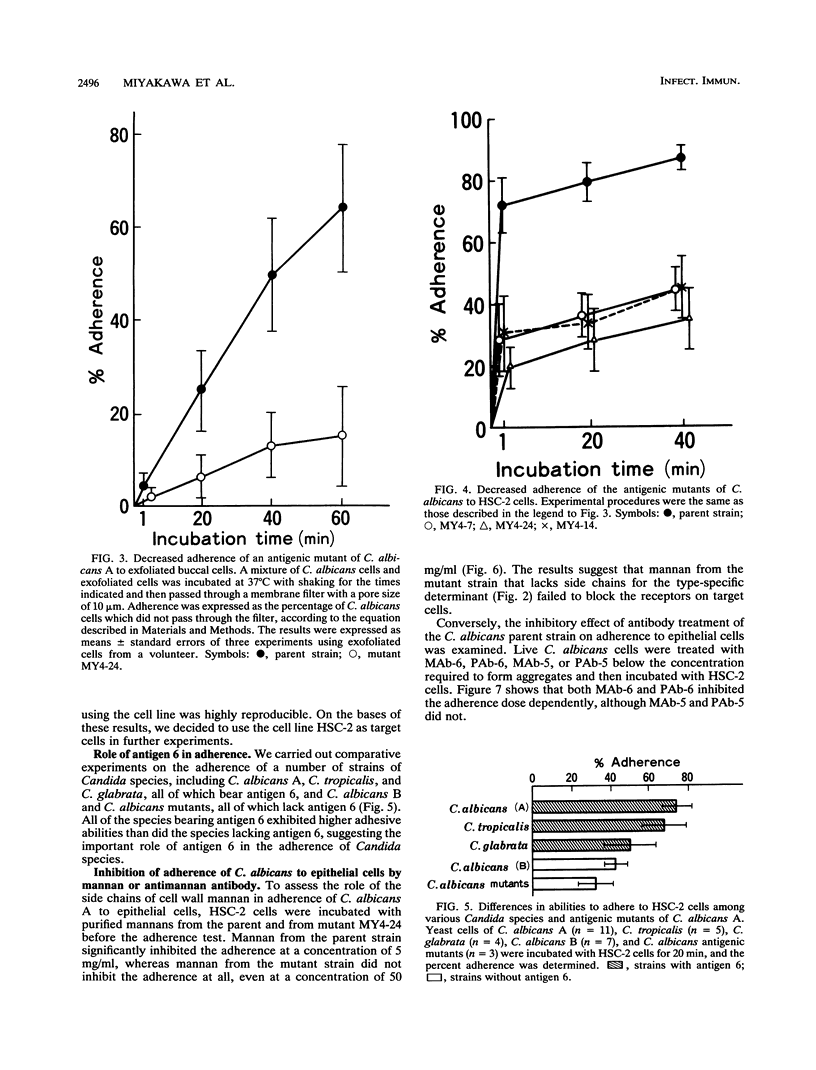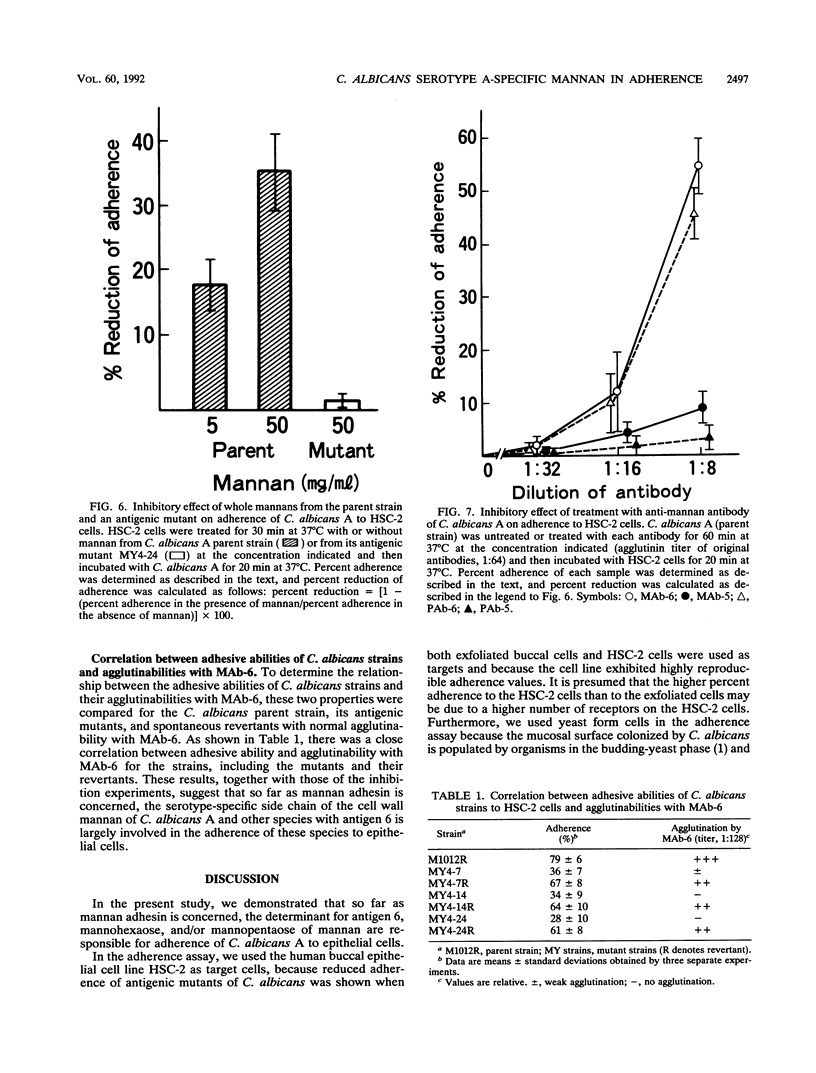Abstract
Candida albicans serotype A (C. albicans A) possesses a specific antigen, designated antigen 6, which resides in mannans on the cell surface. To determine the role of the mannan moiety of the C. albicans cell wall in adherence to buccal epithelial cells, we used antigen 6-deficient mutants which had been isolated by screening with an agglutinating monoclonal antibody against antigen 6 (MAb-6). 1H nuclear magnetic resonance spectral analysis of the purified mannans from the mutants showed a loss of the signals related to that beta-linkage of the side chains. Moreover, acetolyzed fragments of the mutant mannans showed a decreased amount of mannohexaose and mannopentaose. The mutant yeast cells exhibited significantly reduced ability to adhere both to exfoliated buccal epithelial cells and to a human buccal cell line. A number of strains of C. albicans A, C. tropicalis, and C. glabrata, all of which bear antigen 6, showed significantly higher adherence to the cell line than did those of C. albicans serotype B, which lack antigen 6. The whole mannan from the C. albicans A parent inhibited the adherence of C. albicans A to epithelial cells dose dependently, whereas mannan from a mutant strains did not. Moreover, C. albicans A treated with MAb-6 or polyclonal factor 6 serum showed reduced adherence. A close correlation was found between adhesive ability and agglutinability with MAb-6 in the C. albicans A parent, the antigenic mutants, and their spontaneous revertants. These results suggest that so far as mannan adhesion is concerned, serotype A-specific determinants are largely involved in the mechanisms of adherence of C. albicans A to human buccal epithelial cells.
Full text
PDF






Selected References
These references are in PubMed. This may not be the complete list of references from this article.
- Barlow A. J., Chattaway F. W. Observations on the carriage of Candida albicans in man. Br J Dermatol. 1969 Feb;81(2):103–106. doi: 10.1111/j.1365-2133.1969.tb15988.x. [DOI] [PubMed] [Google Scholar]
- Brassart D., Woltz A., Golliard M., Neeser J. R. In vitro inhibition of adhesion of Candida albicans clinical isolates to human buccal epithelial cells by Fuc alpha 1----2Gal beta-bearing complex carbohydrates. Infect Immun. 1991 May;59(5):1605–1613. doi: 10.1128/iai.59.5.1605-1613.1991. [DOI] [PMC free article] [PubMed] [Google Scholar]
- Calderone R. A. Host-parasite relationships in candidosis. Mycoses. 1989;32 (Suppl 2):12–17. doi: 10.1111/j.1439-0507.1989.tb02303.x. [DOI] [PubMed] [Google Scholar]
- Calderone R. A., Scheld W. M. Role of fibronectin in the pathogenesis of candidal infections. Rev Infect Dis. 1987 Jul-Aug;9 (Suppl 4):S400–S403. doi: 10.1093/clinids/9.supplement_4.s400. [DOI] [PubMed] [Google Scholar]
- Centeno A., Davis C. P., Cohen M. S., Warren M. M. Modulation of Candida albicans attachment to human epithelial cells by bacteria and carbohydrates. Infect Immun. 1983 Mar;39(3):1354–1360. doi: 10.1128/iai.39.3.1354-1360.1983. [DOI] [PMC free article] [PubMed] [Google Scholar]
- Critchley I. A., Douglas L. J. Isolation and partial characterization of an adhesin from Candida albicans. J Gen Microbiol. 1987 Mar;133(3):629–636. doi: 10.1099/00221287-133-3-629. [DOI] [PubMed] [Google Scholar]
- Critchley I. A., Douglas L. J. Role of glycosides as epithelial cell receptors for Candida albicans. J Gen Microbiol. 1987 Mar;133(3):637–643. doi: 10.1099/00221287-133-3-637. [DOI] [PubMed] [Google Scholar]
- Douglas L. J. Adhesion of Candida species to epithelial surfaces. Crit Rev Microbiol. 1987;15(1):27–43. doi: 10.3109/10408418709104446. [DOI] [PubMed] [Google Scholar]
- Fukayama M., Calderone R. A. Adherence of cell surface mutants of Candida albicans to buccal epithelial cells and analyses of the cell surface proteins of the mutants. Infect Immun. 1991 Apr;59(4):1341–1345. doi: 10.1128/iai.59.4.1341-1345.1991. [DOI] [PMC free article] [PubMed] [Google Scholar]
- Ghannoum M. A., Burns G. R., Elteen K. A., Radwan S. S. Experimental evidence for the role of lipids in adherence of Candida spp. to human buccal epithelial cells. Infect Immun. 1986 Oct;54(1):189–193. doi: 10.1128/iai.54.1.189-193.1986. [DOI] [PMC free article] [PubMed] [Google Scholar]
- Guentzel M. N., Cole G. T., Pope L. M. Animal models for candidiasis. Curr Top Med Mycol. 1985;1:57–116. doi: 10.1007/978-1-4613-9547-8_3. [DOI] [PubMed] [Google Scholar]
- Hazen K. C., Brawner D. L., Riesselman M. H., Jutila M. A., Cutler J. E. Differential adherence of hydrophobic and hydrophilic Candida albicans yeast cells to mouse tissues. Infect Immun. 1991 Mar;59(3):907–912. doi: 10.1128/iai.59.3.907-912.1991. [DOI] [PMC free article] [PubMed] [Google Scholar]
- Hoberg K. A., Cihlar R. L., Calderone R. A. Characterization of cerulenin-resistant mutants of Candida albicans. Infect Immun. 1986 Jan;51(1):102–109. doi: 10.1128/iai.51.1.102-109.1986. [DOI] [PMC free article] [PubMed] [Google Scholar]
- Kagaya K., Miyakawa Y., Fujihara H., Suzuki M., Soe G., Fukazawa Y. Immunologic significance of diverse specificity of monoclonal antibodies against mannans of Candida albicans. J Immunol. 1989 Nov 15;143(10):3353–3358. [PubMed] [Google Scholar]
- Kennedy M. J. Adhesion and association mechanisms of Candida albicans. Curr Top Med Mycol. 1988;2:73–169. doi: 10.1007/978-1-4612-3730-3_4. [DOI] [PubMed] [Google Scholar]
- King R. D., Lee J. C., Morris A. L. Adherence of Candida albicans and other Candida species to mucosal epithelial cells. Infect Immun. 1980 Feb;27(2):667–674. doi: 10.1128/iai.27.2.667-674.1980. [DOI] [PMC free article] [PubMed] [Google Scholar]
- Kobayashi H., Shibata N., Mitobe H., Ohkubo Y., Suzuki S. Structural study of phosphomannan of yeast-form cells of Candida albicans J-1012 strain with special reference to application of mild acetolysis. Arch Biochem Biophys. 1989 Aug 1;272(2):364–375. doi: 10.1016/0003-9861(89)90230-0. [DOI] [PubMed] [Google Scholar]
- Kocourek J., Ballou C. E. Method for fingerprinting yeast cell wall mannans. J Bacteriol. 1969 Dec;100(3):1175–1181. doi: 10.1128/jb.100.3.1175-1181.1969. [DOI] [PMC free article] [PubMed] [Google Scholar]
- Lee J. C., King R. D. Characterization of Candida albicans adherence to human vaginal epithelial cells in vitro. Infect Immun. 1983 Sep;41(3):1024–1030. doi: 10.1128/iai.41.3.1024-1030.1983. [DOI] [PMC free article] [PubMed] [Google Scholar]
- Lehrer N., Segal E., Cihlar R. L., Calderone R. A. Pathogenesis of vaginal candidiasis: studies with a mutant which has reduced ability to adhere in vitro. J Med Vet Mycol. 1986 Apr;24(2):127–131. doi: 10.1080/02681218680000191. [DOI] [PubMed] [Google Scholar]
- Lehrer N., Segal E., Lis H., Gov Y. Effect of Candida albicans cell wall components on the adhesion of the fungus to human and murine vaginal mucosa. Mycopathologia. 1988 May;102(2):115–121. doi: 10.1007/BF00437448. [DOI] [PubMed] [Google Scholar]
- Maisch P. A., Calderone R. A. Role of surface mannan in the adherence of Candida albicans to fibrin-platelet clots formed in vitro. Infect Immun. 1981 Apr;32(1):92–97. doi: 10.1128/iai.32.1.92-97.1981. [DOI] [PMC free article] [PubMed] [Google Scholar]
- Miyakawa Y., Kagaya K., Fukazawa Y., Soe G. Production and characterization of agglutinating monoclonal antibodies against predominant antigenic factors for Candida albicans. J Clin Microbiol. 1986 May;23(5):881–886. doi: 10.1128/jcm.23.5.881-886.1986. [DOI] [PMC free article] [PubMed] [Google Scholar]
- Miyakawa Y., Kagaya K., Kuribayashi T., Suzuki M., Fukazawa Y. Isolation and chemical and biological characterization of antigenic mutants of Candida albicans serotype A. Yeast. 1989 Apr;5(Spec No):S225–S229. [PubMed] [Google Scholar]
- Miyakawa Y., Kagaya K., Watanabe K., Fukazawa Y. Characteristics of macrophage activation by gamma interferon for tumor cytotoxicity in peritoneal macrophages and macrophage cell line J774.1. Microbiol Immunol. 1989;33(12):1027–1038. doi: 10.1111/j.1348-0421.1989.tb03160.x. [DOI] [PubMed] [Google Scholar]
- Nelson R. D., Shibata N., Podzorski R. P., Herron M. J. Candida mannan: chemistry, suppression of cell-mediated immunity, and possible mechanisms of action. Clin Microbiol Rev. 1991 Jan;4(1):1–19. doi: 10.1128/cmr.4.1.1. [DOI] [PMC free article] [PubMed] [Google Scholar]
- Ollert M. W., Wadsworth E., Calderone R. A. Reduced expression of the functionally active complement receptor for iC3b but not for C3d on an avirulent mutant of Candida albicans. Infect Immun. 1990 Apr;58(4):909–913. doi: 10.1128/iai.58.4.909-913.1990. [DOI] [PMC free article] [PubMed] [Google Scholar]
- Ray T. L., Wuepper K. D. Experimental cutaneous candidiasis in rodents. J Invest Dermatol. 1976 Jan;66(1):29–33. doi: 10.1111/1523-1747.ep12478053. [DOI] [PubMed] [Google Scholar]
- Samaranayake L. P., MacFarlane T. W. Factors affecting the in-vitro adherence of the fungal oral pathogen Candida albicans to epithelial cells of human origin. Arch Oral Biol. 1982;27(10):869–873. doi: 10.1016/0003-9969(82)90043-7. [DOI] [PubMed] [Google Scholar]
- Sandin R. L., Rogers A. L., Patterson R. J., Beneke E. S. Evidence for mannose-mediated adherence of Candida albicans to human buccal cells in vitro. Infect Immun. 1982 Jan;35(1):79–85. doi: 10.1128/iai.35.1.79-85.1982. [DOI] [PMC free article] [PubMed] [Google Scholar]
- Sandin R. L. Studies on cell adhesion and concanavalin A-induced agglutination of Candida albicans after mannan extraction. J Med Microbiol. 1987 Sep;24(2):145–150. doi: 10.1099/00222615-24-2-145. [DOI] [PubMed] [Google Scholar]
- Segal E. Pathogenesis of human mycoses: role of adhesion to host surfaces. Microbiol Sci. 1987 Nov;4(11):344–347. [PubMed] [Google Scholar]
- Shibata N., Fukasawa S., Kobayashi H., Tojo M., Yonezu T., Ambo A., Ohkubo Y., Suzuki S. Structural analysis of phospho-D-mannan-protein complexes isolated from yeast and mold form cells of Candida albicans NIH A-207 serotype A strain. Carbohydr Res. 1989 Apr 15;187(2):239–253. doi: 10.1016/0008-6215(89)80006-0. [DOI] [PubMed] [Google Scholar]
- Shibata N., Kobayashi H., Tojo M., Suzuki S. Characterization of phosphomannan-protein complexes isolated from viable cells of yeast and mycelial forms of Candida albicans NIH B-792 strain by the action of Zymolyase-100T. Arch Biochem Biophys. 1986 Dec;251(2):697–708. doi: 10.1016/0003-9861(86)90379-6. [DOI] [PubMed] [Google Scholar]
- Sobel J. D., Myers P. G., Kaye D., Levison M. E. Adherence of Candida albicans to human vaginal and buccal epithelial cells. J Infect Dis. 1981 Jan;143(1):76–82. doi: 10.1093/infdis/143.1.76. [DOI] [PubMed] [Google Scholar]
- Suzuki M., Fukazawa Y. Immunochemical characterization of Candida albicans cell wall antigens: specific determinant of Candida albicans serotype A mannan. Microbiol Immunol. 1982;26(5):387–402. doi: 10.1111/j.1348-0421.1982.tb00189.x. [DOI] [PubMed] [Google Scholar]
- Whelan W. L., Delga J. M., Wadsworth E., Walsh T. J., Kwon-Chung K. J., Calderone R., Lipke P. N. Isolation and characterization of cell surface mutants of Candida albicans. Infect Immun. 1990 Jun;58(6):1552–1557. doi: 10.1128/iai.58.6.1552-1557.1990. [DOI] [PMC free article] [PubMed] [Google Scholar]


